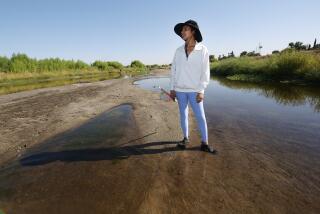‘Wild, Scenic’ Status for Rivers Sought
SACRAMENTO — Environmental activists are campaigning to have more California rivers officially declared “wild and scenic,” excluding the streams from dam building and other commercial development.
The issue is sure to come up next year in Congress. It could also be hotly debated in the state Legislature, with timber, mining and electric power interests opposed.
Sen. Alan Cranston (D-Calif.) says he may carry a bill to confer federal wild and scenic status on parts of three rivers--the Kings, the Merced and the north fork of the Kern.
Rep. Charles Pashayan Jr. (R-Fresno) is drafting an environmental omnibus bill that would put 60.7 miles of the Kern’s north fork in the federal wild river system. That idea is backed by the Reagan Administration, but public interest lobbies such as Friends of the River say it doesn’t go far enough. They want to add another 17 miles.
In Sacramento, Byron D. Sher, the Palo Alto Democrat who chairs the Assembly Natural Resources Committee, is looking at the idea of state legislation to designate rivers as candidates for wild and scenic status and to freeze development on them while studies are made.
20 Million Acres of Forest
Also, the U.S. Forest Service is drawing up long-range use plans for the state’s 20 million acres of national forest. Included will be recommendations for wild and scenic status for parts of some rivers flowing through them.
The issue of an expanded state role in the wild rivers process got a thorough airing last week at an interim hearing of the Natural Resources Committee in Sacramento.
Besides the Kings, Merced and Kern, advocates of protection for three other rivers testified at the hearing. They pleaded the cases of the McCloud River in Shasta County, the South Yuba River in Nevada County, and the Santa Margarita River in San Diego County.
Either the federal or state government can confer wild and scenic status on rivers. Federal action can be taken through a bill passed by Congress and signed by the President, or on a decision by the secretary of the Interior.
In California at present, the only way is action by the Legislature with the approval of the governor.
The state already has six official wild and scenic rivers.
Designated in 1972
Five of them were designated in a state Wild Rivers Act passed by the Legislature in 1972 and signed by tehn-Gov. Ronald Reagan. The original five are the Eel, Klamath, Smith and Trinity rivers in northwest California, and a 23-mile stretch of the lower American River near Sacramento.
These five rivers gained double protection in 1982, when outgoing Democratic Gov. Edmund G. Brown Jr. got U.S. Interior Secretary Cecil Andrus to confer federal wild and scenic status on them in the closing hours of the Carter Administration.
A sixth river, the Tuolumne, was designated wild and scenic under federal law in a wilderness bill passed by Congress last year.
Among the six new candidates mentioned at Sher’s hearing, the McCloud River in Shasta and Siskiyou counties could turn out to be one of the most controversial.
Land for Dam Site Eyed
The City of Santa Clara, which has its own electrical power system, is eyeing a site on the upper McCloud east of Dunsmuir for a 40-foot dam that would produce up to 54.6 megawatts of electricity.
Inclusion of the Tuolumne in the federal wild river system last year frustrated longstanding plans by the Modesto and Turlock irrigation districts for an electric power plant on that river.
“We are trying to become energy independent from Pacific Gas & Electric Co., from whom we buy 50% of our power,” said Santa Clara Deputy City Manager Jennifer Sparacino.
The city is winding up a feasibility study, which Sparacino says contains much of the data needed for a formal environmental impact report. The decision of whether to go ahead with the project has not been made by the City Council.
Tom Hessellenz, manager of the Nature Conservancy’s McCloud River Project, said that “dam construction is by far the biggest threat to the McCloud,” though he stopped short of asking wild river status for it. Six miles of the lower McCloud were swallowed up by Lake Shasta after construction of Shasta Dam. PG&E; also built a dam in the middle portion of the river in 1965.
A publication widely used by environmentalists in the wild rivers debate is the California section of the Nationwide Rivers Inventory, published in 1982 by the U.S. National Park Service.
It lists the special environmental advantages of 65 segments of California rivers, all but three of them in Northern California.
“It serves as a directive for which rivers should be studied,” said Friends of the River lobbyist Beatrice Cooley. “But it isn’t all-inclusive.”
More to Read
Sign up for Essential California
The most important California stories and recommendations in your inbox every morning.
You may occasionally receive promotional content from the Los Angeles Times.










